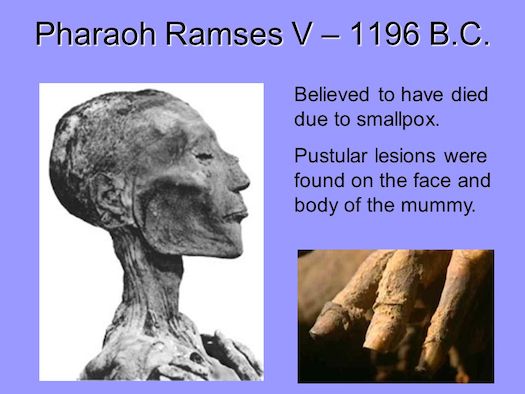
Ramses V
Editor’s NOTE: There are times that we come across articles which we posted many years ago on the various websites of Kettle Moraine, Ltd. Publications. The following was not published on Dr. Kelley’s site, however certainly does have an anchor to health related issues. Interestingly enough, the following was published in a category entitled, ‘To Health With You.’ Enjoy history, but read carefully and wonder about the correlation to similar health related issues of our day. ~ JB
Ramses V, one of the pharaohs of Egypt, is believed to have died from a smallpox infection. Smallpox evolved relatively recently, appearing approximately 10,000 years ago around the time when humans developed agriculture.
Eradicated from the world during the 1970s, few individuals living today have any immunity against this deadly pathogen
The combination of little immunity, a high mortality rate, an even higher morbidity rate, high infectivity and relatively high medical mystery makes smallpox an almost ideal biological warfare agent. Currently, the U.S. government only keeps enough vaccine to protect only a small percent of the population.
The smallpox vaccine is made up of live attenuated cowpox virus, a relative of smallpox. The vaccine is composed of an active agent that is relatively benign but still has the ability to cause some illness.
Public health officials in the United States stopped routine vaccination of all citizens in 1971 because they decided that the risk of dying from the vaccine was greater than the risk of contracting the disease.
According to the National Institutes of Health, the vaccine is deadly for between one and six people per million who receive treatment. The vaccine is significantly more dangerous for people with weakened immune systems, such as the elderly, AIDS patients and cancer patients. Even more people are susceptible to serious side effects from the vaccine, including severe brain inflammation.
The attacks of Sept. 11 may have changed the government’s position that the dangers of the vaccine outweigh the dangers of being exposed to smallpox-the U.S. government has announced plans to accelerate the production of enough vaccine to protect the entire population.
They maintain, however, that they do not plan to vaccinate civilians in the near future, but plan to give the smallpox vaccine to people who may have been exposed. Administering the vaccine to people believed to have been exposed to smallpox is thought to prevent disease.
Relatively little is known about how smallpox causes illness because it was largely eliminated as a disease threat before the advent of modern molecular biology. Some programs, however, continue to study smallpox in efforts to combat the threat of biowarfare.
After replicating inside host cells, smallpox particles recruit a host molecule using one of its own proteins. Using the stolen host cell protein, each virus forces the cell to make a protein ladder to climb out of the cell. Once it has left the first cell, the virus is free to invade more cells and cause more pathology in the host.
Ken Alibek, a scientist who worked for the former U.S.S.R.’s bioterrorism program, Biopreparat, has stated that their scientists stockpiled strains of smallpox that are especially deadly and have a short incubation period.
The short incubation period might prevent the post-exposure vaccine from protecting exposed individuals from developing illness.
Arthur Reingold, an epidemiologist in the UC Berkeley School of Public Health, said that even one case of smallpox in the United States would be devastating.
“If there is ever another case of smallpox, it will be a public health disaster, resulting in panic, quarantine and large scale vaccination,” he said. “If there is an outbreak of multiple cases, things will much worse, and 30 percent or more of the cases will die.”
Reingold added that, in the past, single cases of smallpox have caused wide-spread panic and post-exposure vaccination.
“In theory, we could get away with just vaccinating those with close contact with a case, but in practice (we) would undoubtedly end up vaccinating enormous numbers of persons,” he stated. “One case in Yugoslavia ultimately produced over 100 secondary cases and led to vaccination of 20,000,000.”
 Although no antivirals have been tested on humans, the U.S. Army has tested several different drug therapies in mice. They have found that one drug, cidofovir, is effective at reducing mortality rates. This therapy has been shown to be effective in people with weakened immune systems to treat cytomeglovirus, a different viral infection.
Although no antivirals have been tested on humans, the U.S. Army has tested several different drug therapies in mice. They have found that one drug, cidofovir, is effective at reducing mortality rates. This therapy has been shown to be effective in people with weakened immune systems to treat cytomeglovirus, a different viral infection.
The drawbacks to this medication include that it has never been tested in humans who were infected with smallpox.
Written by Westyn Branch-Elliman ~ October 27, 2003
